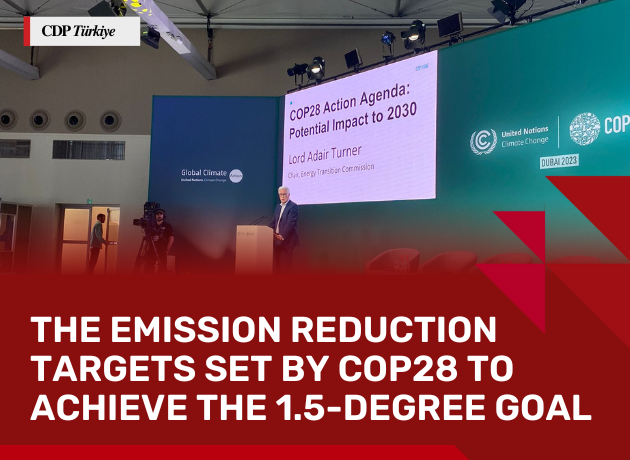
Submitted by sude.figen on December 8, 2023
Speaking at the "COP28: Pace, Progress, and Impacts" event held on December 8, 2023, Lord Adair Turner, Chair of the Energy Transition Commission, outlined the emission reduction targets set by COP28 to achieve the 1.5-degree goal:
Renewable Energy
Tripling the total renewable energy capacity from 3.5 TW to 11 TW by 2030.
Energy Efficiency
Doubling annual improvements in energy efficiency from 2% to 4% by 2030.
Oil and Gas
Achieving net-zero Scope 1 and Scope 2 greenhouse gas emissions by 2050.
Reducing methane usage to zero by 2030.
CCS (Carbon Capture and Storage)
Setting targets for gigaton-scale CCUS (Carbon Capture, Utilization, and Storage) by 2030.
High-Emission Sectors
Launching the Industrial Transition Accelerator.
Deforestation
Protecting, restoring, and sustainably managing forest basins in tropical countries.
Agriculture and Food
Accelerating the development of alternative proteins, innovations in fertilization processes, and actions to reduce methane emissions.

In the first slide, we see the emission reduction targets required to achieve the 1.5-degree goal. The table that emerges from the cautious steps needed to meet this target shows that global greenhouse gas emission targets for 2030 are not being met, leading to a significant shortfall.

However, as seen in the second slide, if all countries work with maximum determination and take strong policy actions to achieve the reduction targets, this emission gap can be significantly closed. Therefore, the NDCs to be submitted in 2025 hold great importance.

If action is taken, this gap will be closed. In particular, the transition to renewable energy and electrification supported by countries is expected to have a direct negative impact on coal and oil use.





